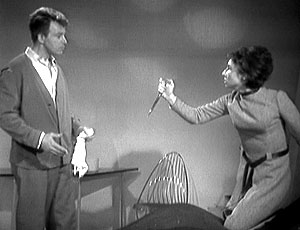The Edge of Destruction has gained a well-deserved reputation as one of the strangest Doctor Who serials ever to have been broadcast and it has often been much maligned. Script problems on other serials coupled with the BBC’s decision to originally only grant the show a trial thirteen episode run had left the makers of Doctor Who with a two episode gap to fill. Story editor (the title of script editor wasn’t used until later in the show’s history) David Whitaker therefore completed the script in just two days basing it all in the one set and using only the four regular cast members. In that respect The Edge of Destruction is unique in Doctor Who and it is an incredibly important serial in the development of all four of the original cast members.
The tone for the serial is set very early with an eerie atmosphere evident right from the opening scene particularly when a zombie-like Susan enters the fray. This eventually turns towards a genuine horror sensibility, which wouldn’t be seen in Doctor Who again for some time and arguably never again to the same extent. The malfunction of the Tardis allows the directors of the serial to exploit some dramatic lighting and the use of only the Tardis set develops a genuinely claustrophobic feel that only adds to the tension. In many ways it is a return to the success of the first episode of the debut serial An Unearthly Child when sharp dialogue and a reliance on the actors resulted in such a darkly atmospheric piece.
The Edge of Destruction is ultimately an actor’s serial. Each character experiences more different emotions in these two episodes than in many other whole serials. Susan in particular takes on a much more interesting role here than she had previously played in The Daleks, where even at that early stage in the series the character had begun to fall into what would later become known as the stereotypical role of ‘the screamer’. This is most famously exhibited in the scene in which seemingly possessed she threatens Ian with a pair of scissors. This in itself would be extremely shocking, but the moment when she begins to repeatedly stab the chair beneath her in a frenzied state is one of the most surprising in Doctor Who history. Unsurprisingly it garnered some complaints and the producers of the show admitted that in that instance they had gone too far for a childrens programme. While this is undoubtedly true and it would be unthinkable to see such a scene in Doctor Who these days, it is nonetheless a wonderfully powerful image and adds an incredibly dramatic threat.
Under the pressure of carrying the story the cast do an excellent job. There are occasional moments where William Russell and Carole Ann Ford both slightly overplay their ‘possession’ (also it’s noticeable in all the early shows how difficult it is to convincingly act fainting), but these are the exceptions and at a time when one-take was the norm they can certainly be forgiven the odd indiscretion. The stand-out performer unquestionably though is Jacqueline Hill as Barbara. It’s hard to think of any actor in the show’s fifty year history who put in such consistently wonderful performances as Hill and she is simply superb here. She invests the character with a quiet dignity at all times and is totally believable throughout. The scene in episode one where all the clock faces on the Tardis have melted is let down by the effects and it is quite hard to work out exactly what has happened on first watch, however Hill’s reaction and her genuine sense of anguish completely sells it and overcomes the shortcomings caused by the shows meagre budget.
The relationship between the crew of the Tardis changes dramatically after The Edge of Destruction and for that reason it stands as one of the most important serials in the shows long run. While the tension and conflict between the four main characters had worked to make the show an engaging and dramatic success over the early episodes it would have been hard to sustain such an atmosphere for much longer. Key to the change is the development of the Doctor’s character. Up until this serial he had been unsympathetic, crotchety and generally untrustworthy with moments of selfishness and cowardice thrown in. For much of The Edge of Destruction little seems to have changed. His first reaction to the signs that things are starting to go wrong is to accuse Ian and Barbara of meddling and his only shows of concern are once again towards Susan. As episode one progresses his accusations grow in size leading to a wonderful scene in which Barbara fights back, legitimately pointing out that without his new companions he would almost certainly have been killed in his two previous adventures and ultimately calling the Doctor “a stupid old man”, a speech again brilliantly delivered by Jacqueline Hill. He repeatedly ignores Ian and Susan’s pleas to apologise to Barbara and by the beginning of episode two his anger and aggression has grown even further towards them. What is perhaps more surprising is to see Susan, though very briefly, also turn on her friends and it is noticeable again that Hill plays Barbara’s reaction to her accusations differently and with a greater air of desperation than The Doctor’s. The darker edge to the Doctor’s character is once again drawn out when he states that Ian and Barbara must be treated as enemies and be punished as such. The reaction of Susan to this statement leaves viewers in no doubt of the seriousness of the punishment and once again shows the threat that the Doctor posed in the early stage of his development.
The first chink of light in the relationship between the Doctor and his companions comes midway through episode two when he realises that he was wrong in his accusations and states the necessity of them all working together to survive, admitting for the first time that he needs them. This is borne out when once again the Doctor seems out of ideas and ready to prepare for death and it is Barbara who again shows some proactivity in trying to unravel the mystery of what has happened to the Tardis. He does show some signs of compassion and concern, albeit by todays standards in an unacceptably sexist manner by sheltering the two girls from the truth of how long they potentially had left to live and encouraging Ian to face death alongside him. When eventually the problem is worked out and danger is averted there is an immediate change in the Doctor’s character, he is apologetic and warm towards Ian and when setting the Tardis controls he for the first time shows a genuine excitement about traveling with his new friends. The final scene of the serial where he makes his apology to Barbara takes these changes further and the warmth and friendliness of the Doctor is clearly evident, as is the beginnings of a bond between him and Barbara that will arguably be the strongest of any of the first Doctor’s with his companions.
Alongside the four regular cast members, the fifth character in The Edge of Destruction is the Tardis itself, as this is the first indication that it is more than simply a ship. Thanks to the new series in particular we are now entirely familiar with the idea that the Tardis is a living breathing entity, but it’s clear that even as Ian and Barbara made the first suggestion that maybe it could think for itself, the writers had no such concrete plans. The Doctor initially dismisses the idea, though shortly after admits that it is possible that in a different way to theirs it might have some capacity for thought. In doing so Whitaker added a further layer of mystery to the show.
The climax of the mystery is in many ways quite disappointing. After the drama and tension of the two episodes to discover that it had all been caused by a single switch being stuck in place is slightly anti-climactic. particularly as the idea of the Tardis having a ‘fast-return’ button is a slightly clunky device anyway (this isn’t helped by the famous mistake of having the words ‘fast return’ written in marker pen above the switch, supposedly as a rehearsal aid for Hartnell). Despite this The Edge of Destruction is a classic example of the journey being more important than the ending. It represents the beginning of the Doctor as we know him and slowly turns the Tardis crew from reluctant companions into genuine friends. Not bad for a serial that was never planned.







